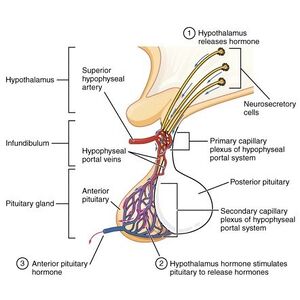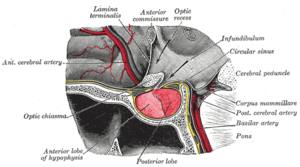Hypothalamohypophyseal regulation
Hypothalamus[edit | edit source]
The Hypothalamus is a part of the diencephalon containing the control center of the body's autonomic nervous system. It creates hormones by itself, namely:
- liberins and statins, which regulate the release of hormones from the adenohypophysis;
- antidiuretic hormone (from nucleus supraopticus hypothalami) and oxytocin (from nucleus paraventricularis hypothalami).
It is associated with the pituitary gland, namely:
- vascularly – it is connected to the adenohypophysis by a portal system. A. hypophysialis superior, a branch of a. carotis interna, breaks up into the primary capillary plexus at the level of eminentia mediana hypothalami, where liberins and statins are released into it. The primary capillary plexus rejoins into the portal veins, which subsequently disintegrate into the secondary plexus. This is located around the adenohypophysis, where liberins and statins are absorbed. On the contrary, hormones produced by the adenohypophysis itself pass into the blood. This phenomenon, when the capillary plexus is inserted between vessels of the same type, is called rete mirabile.
- neurally – it is connected to the neurohypophysis by unmyelinated axons of neurons of the hypothalamic nuclei (nucleus supraopticus et paraventricularis). These axons form the stalk of the pituitary gland and are used to transport antidiuretic hormone ADH, vasopressin) and oxytocin. to the posterior lobe of the pituitary gland . The pathway formed by these axons is called the hypothalamo-hypophyseal tract.
The pituitary gland[edit | edit source]
The pituitary gland is an oval extension of the end of the infundibular process of the hypothalamus. It is located in the sella turcica of the sphenoid bone and is composed of two anatomically, functionally and developmentally different parts – the adenohypophysis (with an epithelial structure) and the neurohypophysis (with a neural structure). The neurohypophysis and the adenohypophysis are connected to each other by a short portal circulation (a. hypophysea inferior).
Adenohypophysis[edit | edit source]
The adenohypophysis is the anterior lobe of the pituitary gland. Hormone production by the adenohypophysis is regulated by liberins and statins from the hypothalamus. It is vascularly connected to it by the hypophyseal portal circulation. It consists of three parts
- pars distalis – the main part of the adenohypophysis responsible for the production of most hormones, formed by beams of chromophobe and chromophile cells. Chromophilic cells are further divided into acidophilic and basophilic cells.
- pars intermedia – poorly developed part formed mainly by basophilic cells.
- pars tuberalis – mainly contains chromophobes and Rathke cyst cells
Hormones of the adenohypophysis[edit | edit source]
Acidophilic cells produce simple proteins and predominate in squamous epithelium, they include two main cell types:
- somatotropic cells − somatotropin (STH), growth hormone - supports proteosynthesis, and thus individual growth, acts on the proliferation of chondrocytes in the growth plates;
- mammotropic cells − prolactin (PRL), stimulates mammary gland development and milk production.
Basophilic cells of the pars distalis secrete glycoproteins – they are PAS positive:
- thyrotropic cells − thyrotropic hormone (TSH), stimulates the synthesis and release of thyroid hormones;
- gonadotropic cells − follicle-stimulating hormone (FSH), in women it stimulates ovarian follicle maturation, in men it supports spermatogenesis and luteinizing hormone (LH), inhibits egg growth and increases the effect of estradiol on the storage and consumption of cholesterol in granulosa lutein cells, supports the production of sex hormones;
- corticotropic cells − adrenocorticotropic hormone (ACTH), stimulates the growth of the adrenal cortex and the production of glucocorticoids.
In the basophilic cells of the pars intermedia, it is additionally formed:
- melanocyte-stimulating hormone (MSH) – stimulates melanocytes to produce melanin and transfer its granules to keratinocytes in the skin and hair.
Neurohypophysis[edit | edit source]
The neurohypophysis, or posterior lobe of the pituitary gland, is made up of axons of neurosecretory neurons and glial cells (so-called pituicity). It is nervously connected to the hypothalamus and through this route it also receives antidiuretic hormone and oxytocin, which are only stored in the pituitary gland and released into the blood by exocytosis after stimulation by an action potential.
- oxytocin – induces contractions of the uterus during childbirth and contraction of the milk ducts during breastfeeding.
- antidiuretic hormone – increases reabsorption of sodium ions and water in the distal tubule and collecting duct of the kidneys.
Used literature[edit | edit source]
- KITTNAR, Otomar, et al. Lékařská fyziologie. 1. vydání. Praha : Grada, 2011. 790 s. ISBN 978-80-247-3068-4.
- ČIHÁK, Radomír a Miloš GRIM. Anatomie. 2. upr. a dopl vydání. Praha : Grada Publishing, 2002. 470 s. sv. 2. ISBN 80-247-0143-X.
- KONRÁDOVÁ, Václava, Jiří UHLÍK a Luděk VAJNER. Funkční histologie. 2. vydání. Jinočany : H & H, 2000. 291 s. ISBN 80-86022-80-3.




